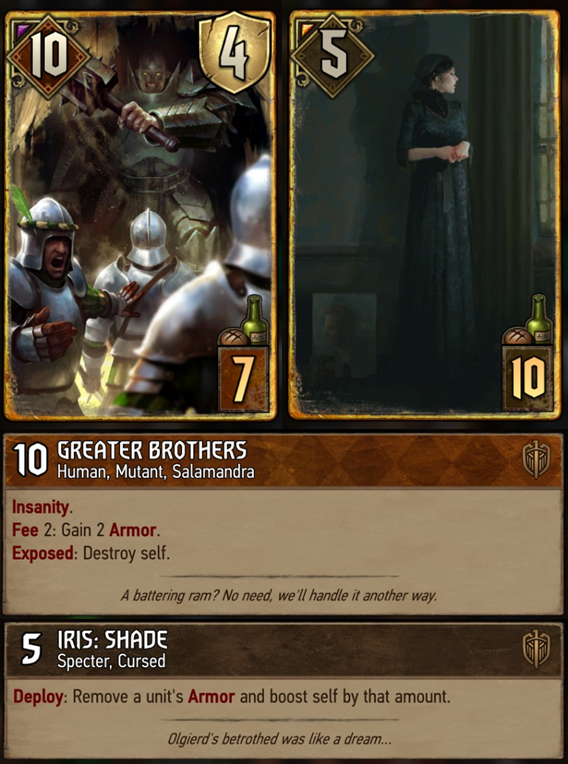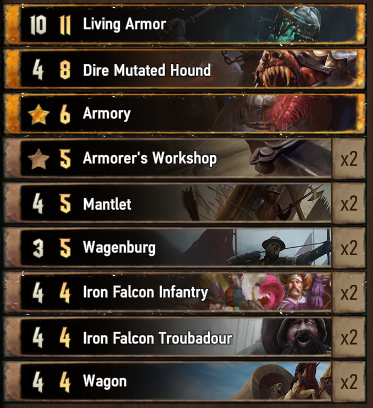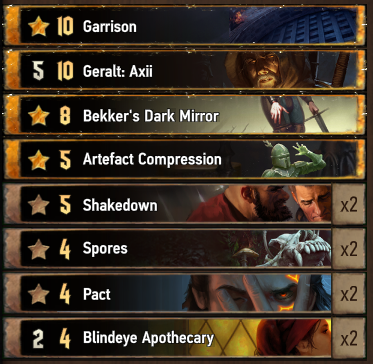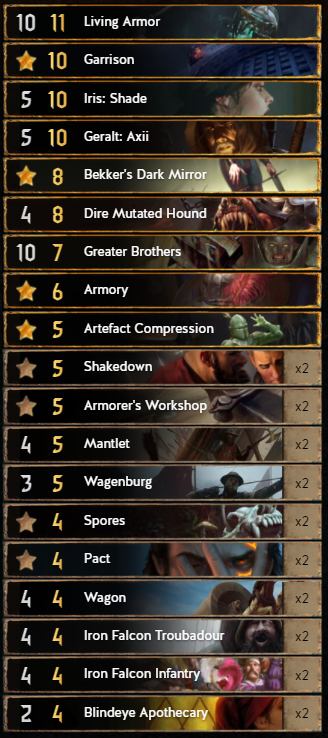
By Xyptero, September 30, 2020

Last time, we talked about the three fundamental features of a deck. Today, we’re looking at the first of those – your win condition. This is the deck’s game plan; the main strategy you will use to win, and though they can come in many forms, most are centred around a particular mechanic.

Deckbuilding with Xyptero: Part 2 - Building a Win Condition
Here are a few good places to start; when I build a new deck, the first thing I do is pick the mechanic that will be my win condition. Then, I look for cards to support that win condition by pursuing a series of questions:
1. How does this mechanic work?
2. What features of this mechanic can be exploited?
3. What tools do I need to exploit those features?
4. How can I get those tools?
These questions lead me to the cards that will form my ‘core package’—the section of the deck devoted to the win condition—and form the basis for the rest of the deck.
Let’s have a look at how this works in practice: I’ll build a deck from scratch, starting with the win condition.
Step One: Find an Interesting Mechanic
First, we need to pick a win condition.
This is as simple as it sounds, Almost anything can be a win condition, so my advice is this: pick a mechanic that is somehow related to points—any mechanic you like—and try to build a deck around it. Here’s where I started with this deck: I found an interesting mechanic.

Greater Brothers can gain armour by spending coins or damaging itself. Iris: Shade strips all the armour off something and boosts herself by the armour removed. So, here’s the plan: we stack a whole bunch of armour on Greater Brothers, then use Iris: Shade to convert it to points.
Step Two: Identify Exploitable Features
This is where the questions come in. How can I exploit the features of these cards?
How does this mechanic work?
- Iris: Shade strips armour from another unit and turns it into points
- Fee: Greater Brothers can pay 2 coins to gain 2 armour
- Insanity: If you have no coins, Greater Brothers can take 2 damage to gain armour instead
With no other cards involved, Greater Brothers can damage itself by 8, making 12 total armour. Iris: Shade strips this for 12 boost on top of a 5-point body, and the now armourless Greater Brothers destroys itself. That’s 17 points for 17 provisions across two cards, which isn’t terrible, but isn’t game-winning either. To build a deck around this win condition, we need some ways to increase its efficiency, which brings us to our next question.
What features of this mechanic are exploitable?
1. All of Greater Brothers’ armour ends up as points, including any we give it from other cards.
2. Greater Brothers can use insanity to convert points to armour, again including points gained from other cards.
3. We’re storing all these points as armour, so they’re somewhat safe from tall removal.
What tools do I need to exploit these features?
1. Efficient ways to put armour on Greater Brothers.
2. Efficient ways to put points on Greater Brothers.
3. We want the last play so our points are never exposed to tall removal, but that’s a consideration for later.
Step Three: Find Cards for Your ‘Shortlist’
How can I get these tools?
At this stage, we don’t care about deck size or provision budget—that will come later. For now, we’re just making a list of useful cards. If it seems useful to our win condition, it goes in the deck.
Let’s take a look at the options.
Tools: More Armour on Greater Brothers, Efficiently
Deckbuilder search tips: You can search by faction in the filtering options, but to combine one faction and neutrals you must be creating a deck. Searching from within the deck editor will restrict results to the chosen faction and Neutral cards.

Hitting ‘New Deck’ is the best way to filter out cards from other factions, so I created a new Syndicate deck with a random leader.
A quick search for ‘armor’ returns 18 results among Syndicate and Neutral cards. Excluding cards which are already in the deck (Greater Brothers and Iris: Shade), cards used to remove armour, and a couple that only appeared because their name contains the word, we’re left with six cards that can give armour to Greater Brothers:
1. 2x Wagon
2. 2x Iron Falcon Troubadour
3. 2x Wagenburg
4. 2x Mantlet
5. 2x Armorer's Workshop
6. Armory
All of these go in the deck (for now, at least – remember, we’re just gathering a shortlist).
We’re on the lookout for other cards that work nicely with armour synergies as well. Looking through the results for ‘armor’ and ‘barricade,’ I found a few:
7. Living Armor – another way to convert armour into points.
8. Dire Mutated Hound – a powerful 2-point engine, which we have easy ways to reactivate.
9. 2x Iron Falcon Infantry – a cheap engine, activated by armour.
Tools: More Points on Greater Brothers, Efficiently
Deckbuilder search tips: Phrases like ‘boost a unit’ or ‘boost an ally’ will return more targeted search results, but may be less comprehensive. Here, these terms would leave out Bekker's Dark Mirror!
I searched for ‘boost’ and look through the results. Most of the cards shown boost themselves, but a few could be efficient ways to boost Greater Brothers:
1. Pact – we don’t care about doomed, as we can’t resurrect it anyway.
2. Shakedown – actually worth 7 points total, as Greater Brothers having odd power means we can use insanity an extra time.
3. Bekker's Dark Mirror – 16 points, or 18 if we can get Greater Brothers to 1 power beforehand (which we can, using Shakedown!) Incredibly good value.
4. Garrison – 10 for 10p: good points for a single card, and Greater Brothers ‘hides’ the value as armour which mitigates the risk of playing into tall removal.

Remember, there are often many ways to do something in Gwent. ‘Damage’ might be the most obvious way to remove a unit, but also consider searching for ‘Destroy,’ ‘banish,’ and ‘seize’!
Boosting isn’t the only way to put points on a unit, however. Greater Brothers can damage itself with insanity, so the ‘heal’ and ‘reset’ keywords may be useful as well.
5. Blindeye Apothecary – Heal plus a 2-point body is 10-11 points – ridiculous value!
6. Spores – Reset for 8-9 points.
7. Artefact Compression – Same as Spores, but also locks the unit. Greater Brothers
won’t be able to generate any more armour, but also won’t be destroyed when the armour is removed! 10 points with Iris: Shade, and a solid offensive option as well.
8. Geralt: Axii – 13-14 points for 10p is good, but less stellar than other cards here. The purify could be useful against Poison however.
Step Four: Assess Limitations
Remember earlier, when we noted that stacking points on Greater Brothers keeps them safe from tall removal, but only if we have last say?

Every win condition has weaknesses and limitations that we need to plan for and work around. By this point, we’ve assembled a preliminary shortlist of cards that seem useful to our win condition. This should be enough to give us an idea of how the win condition will work, and let us identify some problems.
Problem One: This win condition is single-use. We only have one copy of Greater Brothers, and one copy of Iris: Shade, which means we need some other way to get through the other rounds.
Problem Two: The Greater Brothers combo is poorly suited for Round One. Because all of our points are stored as armour, we have very few points actually on the board during the round. If we used the combo in Round One, our opponent could pass whenever they wished, and we’d still have to take another turn to play Iris: Shade and convert all that armour into points.
Problem Three: we’ve actually noted already: After converting the armour into points, we have one massively tall unit that’s horrifically vulnerable to tall removal and resets. If we don’t have last say, we’ll lose a lot of matches like this.
So, our combo needs to be played in the final round, and we want last say. That means we need either another strategy to reliably win Round One, or a way to gain card advantage.
We have a few options:
1. Put in another package that can reliably win Round One
Pros:
· Most of our Armour Combo powerplays are quite cheap, so we actually have a lot of provisions to work with – creating a high-tempo Round One strategy is very doable
· Keeps all our best armour-synergy plays for the Greater Brothers combo
Cons:
· Needs a bunch of tutors to make sure the right cards are available
· If not playing in Round One, many of these cards will be less useful in the last round
2. Use armour-synergy cards like Dire Mutated Hound and Living Armor in Round One
Pros:
· Complete focus on armour synergy makes for fewer situational bricks
· Pieces not used in Round One add to final-round combo
Cons:
· Using precious combo pieces like Wagenburgs leaves less for Greater Brothers
3. Don’t commit to Round One, convince them not to bleed too hard in Round Two, and put in Ciri: Dash or a similar source of card advantage to give us last play in Round Three.
Pros:
· Keeps all our best armour-synergy plays for the Greater Brothers combo
Cons:
· Flimsy, unreliable
In situations like this, if I’m not sure which option is best, I’ll often create incomplete decks for each of the options I like, then compare to see which I like more. In this case, I actually put together a number of decks using different Round One packages.
For this article, however, we’ll go with something between options one and two. Our Round One strategy will remain built around armour synergy with Dire Mutated Hound and/or Living Armor, but we may include some expensive non-armour powerplays as well.
Step Five: Refine Your Core Package
We have a collection of cards that might be useful, and a good idea of our win condition’s strengths and limitations. Now it’s time to refine that shortlist into a strong core package.
There’s a few easy inclusions:
· Greater Brothers - central to our win condition.
· Iris: Shade - ditto.
· 2x Blindeye Apothecary – Fantastic value, and it doesn’t brick when played separately from the combo.
· Bekker's Dark Mirror – Equally ridiculous value.
· 2x Wagenburg - Solid value, difficult to disrupt, and easy to reactivate.
…and a few easy exclusions:
· Garrison - What’s the point if I can get the same value from a 4p bronze?
· Wagon - Conditional, and we have better ways to both reactivate engines and boost Greater Brothers.
· Iron Falcon Troubadour – Conditional, and just doesn’t stack up to the other bronzes on offer.
The rest of it is a bit trickier. Try not to agonise over these decisions too much when building your own decks – it’s easy enough to remove a card or add one back in later.
· Mantlet (stays in) - Lower value than Wagenburg, but it makes everything else harder to disrupt. We’ll keep both copies, as we’ll probably want to play one in Round One as well.
· Dire Mutated Hound (stays in) - High-value engine, easy to reactivate.
· Iron Falcon Infantry (stays in) - Cheap and reliable engine with a Wagenburg on the board. If we’re lucky, it might bait out locks or removal.
· Living Armor (stays in) - Not brilliant without Wagenburgs/Mantlets, but with them it’s basically an engine that comes down at 10 points.
· 2x Armorer's Workshop (stays in) - Great for reactivating Wagenburg/Dire Mutated Hound/Mantlet. A little awkward with Living Armor (which can’t gain the boost), so I’ll have to pay attention to unit positioning. Might remove the second copy later.
· Armory (stays in) - 9 points for 6p, and can reactivate a Wagenburg or Dire Mutated Hound in a pinch.
· 2x Shakedown (stays in) - Great for getting Greater Brothers to an odd power value, and decent when played alone.
· Artefact Compression (stays in) - High value, and great offensively in some matchups.
· Spores (out for now) - Better value than most cards here, but it competes with Blindeye Apothecary for the same function, and threatens to brick in other rounds. Situational offensive value is better served by Artefact Compression.
· Pact (one copy) - Flexible card, decent value outside of the combo. Might remove this later.
· Geralt: Axii (out for now) - Although it’s good value, if there’s not a lot of need for a defensive purify on Greater Brothers specifically then we get better value from bronze cards. I’ll keep this one in mind for later when we’re playtesting.
I’m adding in a new card as well – Necromancy Our Wagenburgs will be in high demand in all rounds of a match, so I’m more than willing to spend a few provisions for a third one. It’s always worth keeping in mind cards like Necromancy, Renew, and Operator while deckbuilding – ask yourself: are any of these cards so useful in a deck that it’s worth jumping through hoops for more of them? In this case, I think the answer is yes.
Recap
A good place to start when building a new deck is the win condition, as this is the basis that the rest of the deck is built around. Find a mechanic that you like, and it will lead you to the cards for your core package:
1. How does this mechanic work?
2. What features of this mechanic can be exploited?
3. What tools do I need to exploit those features?
4. How can I get those tools?
Assembling a shortlist of potentially useful cards will also help you work out how your chosen win condition can be used, and perhaps more importantly what its limitations are. This knowledge can then help you refine your shortlist into a core package – or a draft of one at least.
So, if we have a core package, what now? Well, if you recall from part one, a deck needs a win condition, consistency, and versatility. We’ve just built the win condition, so next up is the rest of it: we need the consistency to ensure we have the cards we want, when we need them, and that they stay alive enough to be useful; and the versatility to handle whatever the opponent is doing.
Join me next time for Deckbuilding #3 – Supporting Your win condition.

Author



